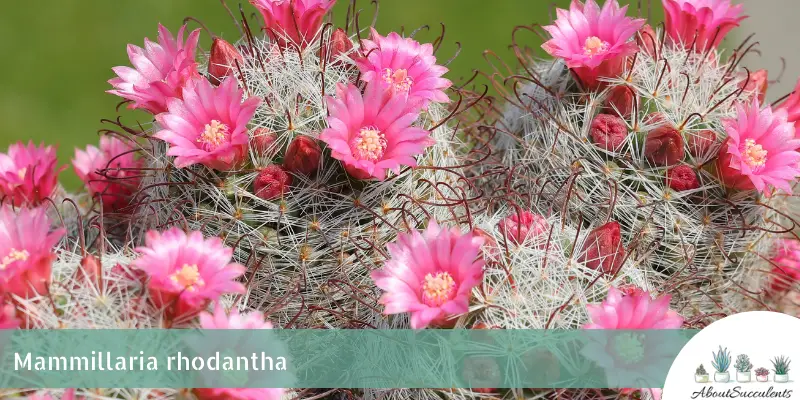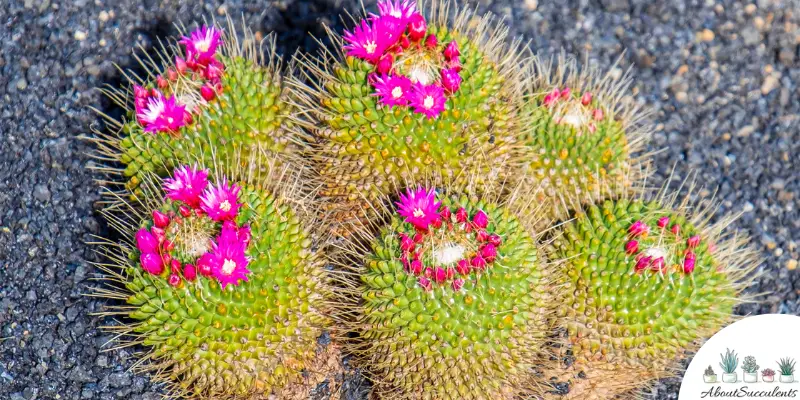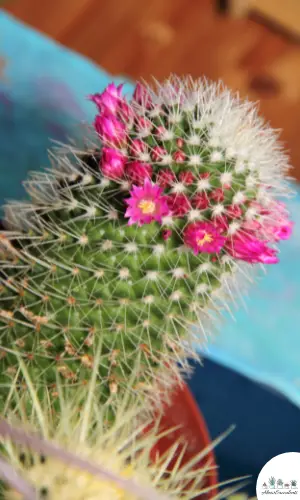
Mammillaria Rhodantha is an interestingly attractive cactus type of succulent plant that is characterized by the variety of spines adorning its apex. It has 30 radial spines that are colored yellow, measure 1cm (0.39”), and 6 longer reddish-brown colored central spines that curve inward toward the apex.
In some plants of this type, the apex might be covered with a white, wool-like material.
Also known as Rainbow Pincushion and Nipple Cactus, this is a slow-clumping cactus with a dark green body. It produces beautiful magenta-colored flowers from spring to fall that measure 1.5cm (0.59”) in diameter.
Botanists have discovered an interesting bit of trivia that could make you the winner of any succulent-themed Trivia Night party.
The spines of Mammillaria Rhodantha perfectly conform to the Fibonacci sequence of numbers!
The stems of Rainbow Pincushion are globular in shape that becomes columnar as it matures. The succulent cacti can grow to a height of 30.5cm (12”). It’s native to Mexico and is a member of the Cactaceae family.
General Information:
Also known as: Rainbow Pincushion, Nipple Cactus.
Plant Family: Cactaceae
Origin: Native to Mexico
Height: 30.5cm (12”)
Exposure: 4 to 6 hours of partial to full exposure to the morning sun. Indoors, place in a location that receives 4 to 6 hours of partial sunlight.
Water Needs: Use the soak and dry method where water is given when the soil is 100% dry.
Soil Type: Commercial potting mix with added grit, perlite, or pumice to improve drainage.
Soil pH: 6.1 to 7.8
How to Grow and Care for Mammillaria Rhodantha

It might be a bit tricky because of the spines, but don’t worry because rugged Mammillaria Rhodantha is an easy succulent plant to grow and care for.
Keep in mind that Rainbow Pincushion does not do well in environments where the temperature can drop below -17° C (0° F). If your region gets this cold, it would be best to plant the cactus in a movable container.
Sunlight
As an outdoor succulent, plant Mammillaria Rhodantha in a location in the garden that gets 4 to 6 hours of partial to full morning sunlight.
If you plan to grow Nipple Cactus as a home ornament, place the container in an area that receives 4 to 6 hours of direct or partial sunlight every day.
Watering

Mammillaria Rhodantha is similar to cactus varieties in that it requires less water than most succulent plants.
It’s great to show your succulents much love – but too much water can do more harm than good. When it comes to watering, neglect is better than attention.
To find out if Rainbow Pincushion needs water, simply insert a stick 1 to 2 inches into the soil. If the stick comes out dry, give the soil a thorough soaking that water begins to leak out of the drain hole.
Expect the watering schedule to be greatly reduced during the winter months as the soil tends to hold on to moisture longer.
If you were watering Nipple Cushion’s soil once every 7 to 10 days in the summertime, you might be giving it water only once a month in the wintertime.
Pot and Soil
You will have to re-pot Mammillaria Rhodantha every few years because it might grow too heavy at the top or because you have been rewarded with many offsets.
When choosing a pot, prioritize the type of material, size, and availability of a drain hole. The best material for a pot is either ceramic or terracotta because it allows moisture to escape from the soil easily.
The roots of Mammillaria Rhodantha grow fast. Choose a pot that is large enough to allow the roots to grow without getting entangled and air to properly circulate within the soil.
Rainbow Pincushion will grow best in standard potting soil or a commercial cactus mix with added ingredients such as perlite, pumice, sand, or gravel to improve drainage.
It’s perfectly fine to add fertilizer to give the soil more nutrients. Choose a brand of fertilizer that has been specially formulated for cactus and is low in nitrogen but high in potassium and phosphorous. Make sure the fertilizer is diluted to half-strength before adding to the soil.
How to Propagate Mammillaria Rhodantha
It’s easy to propagate Mammillaria Rhodantha because it grows pups or offsets near the base of the plant.
You can also propagate with seeds but it can be quite difficult.
Method 1: Offsets
Step 1: Gently pull out the offsets from the base of the mother plant or cut it off with a sterilized and sharpened knife.
Step 2: Allow the offsets to develop hard calluses over a period of 2 to 3 days.
Step 3: Plant the offsets in well-draining soil and position the pot in an area that gets indirect sunlight.
Step 4: Lightly mist the soil until the roots take firm hold.
Step 5: When the roots have taken hold of the soil, give it water only when the soil is completely dry.
Method 2: Seeds
Step 1: Rainbow Pincushion develops white-colored fruits. When the fruits have ripened, you can open them up and collect the seeds.
Step 2: Allow the seeds to dry out.
Step 3: Once the seeds have dried out, plant them in well-draining soil.
Step 4: Lightly moisten the soil and cover it with plastic wrap.
Step 5: Place the pot near an area that receives indirect sunlight to start the germination process.
Step 6: Once the roots have taken hold of the soil, remove the plastic wrap.
Step 7: Water the soil only when it’s 100% dry.
Frequently Asked Questions
Is Mammillaria Rhodantha Toxic to Cats and Dogs?
Mammillaria Rhodantha is not listed as a toxic plant on the website of the American Society for the Prevention of Cruelty to Animals (ASPCA).
However, keep Rainbow Pincushion far away from your pets because of its spines.
Why Is My Mammillaria Rhodantha Dying?
Mammillaria Rhodantha is a tough and durable plant but overwatering and pest infestation can lead to its downfall.
Overwatering
If you see black spots appear on the base of Rainbow Pincushion or notice that the stems look and feel mushy, the problem might have already gone from roots to inside your plant.
These are clear signs of a fungal infection that’s working its way from inside Nipple Cactus. The starting point of the infection can be found at the roots and this was certainly caused by overwatering.
Immersing the roots in a moist environment will cause the cells to expand and eventually explode. The succulent plant then becomes susceptible to infection.
It’s not too late to save Mammillaria Rhodantha. Get a sterilized pair of garden scissors or a clean and sharpened knife and cut off all the infected parts. Wipe the cutting tool after every use to prevent further contamination.
Remove the Rainbow Pincushion from its pot and shake off the excess soil. Cut off all the roots that have rotted away. Place the succulent plant in a clean and warm area and let it dry off.
Fill up a new pot with fresh, well-draining soil, and re-plant Mammillaria Rhodantha in its new home.
Pest Infestation
Mammillaria Rhodantha attracts plenty of pests such as mealybugs, fungus gnats, spider mites, and scale insects.
You might notice them because they’re so tiny. If you see white, cotton-like matter on the stems of Rainbow Pincushion, it means a number of pests have made your plant their home.
Wipe off the white, cotton-like matter with a cotton swab soaked in 70% isopropyl alcohol. Try spraying Mammillaria Rhodantha with neem oil or pyrethrins first. If the pests are still present, use a mild pesticide and see if it works.
As a last resort, try systemic pesticides such as acephate and imidacloprid.
Does Mammillaria Rhodantha Produce Flowers?
Yes, Mammillaria Rhodantha produces eye-catching magenta-colored flowers from spring to autumn.
Last Updated on June 9, 2022 by Sofia Lara